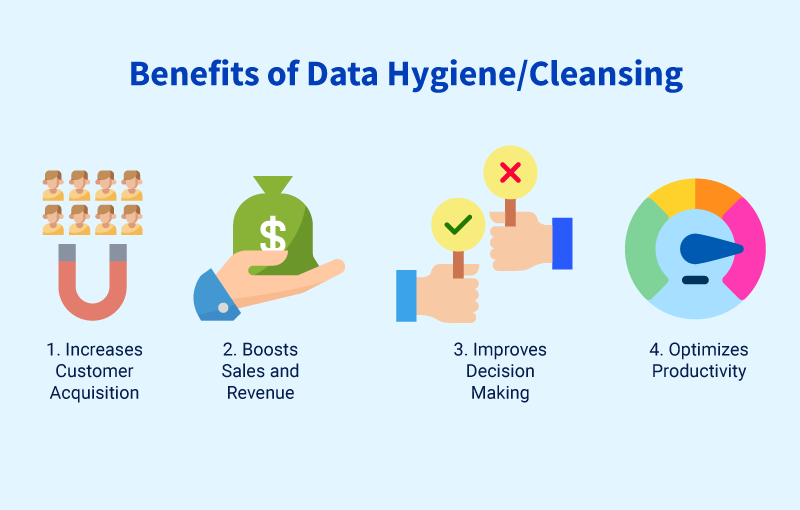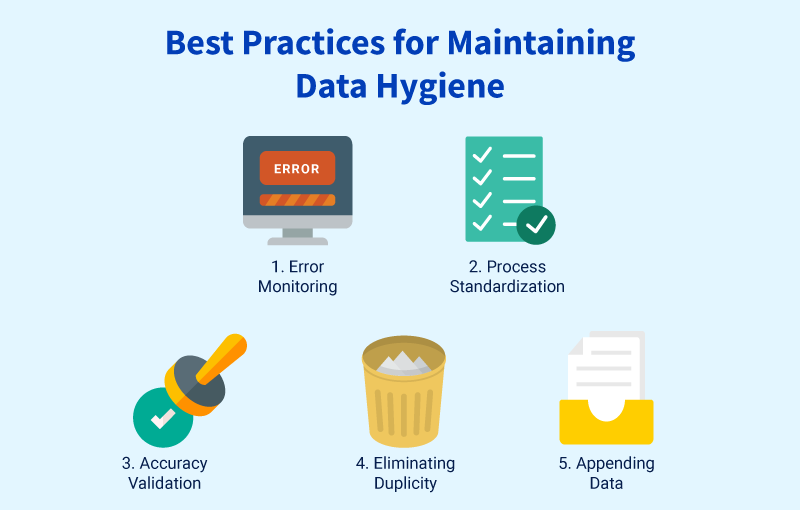The rate at which your customer database decays is 30% annually and this is a conservative estimate. Maintaining data hygiene is critical for your business’s success. Find out how you can keep your data clean by following the steps mentioned in this article.
Data is at the core of every business decision these days. The HR departments are gathering it from various online sources to recruit the best people and conduct quick background checks on them. Marketing departments use data exhaustively to generate a deeper understanding of their customers, track leads and speed-up the sales process wherever they can. Business executives employ data to examine market trends such as changes in resource pricing, manufacturing, logistics, etc. Data analytics is bringing about a slow revolution and has become an irreplaceable component in devising effective business strategies.
However, it is not enough to simply acquire mountains of data. Businesses need to learn how to effectively use data to make decisions. There is an insurmountable amount of data available with companies today. But only a chunk of it is useful. A block of relevant data can be mined by analytics and data scientists. Once data is mined, it needs to be cleansed to make it more powerful and valuable for users. Maintaining data hygiene by cleaning it through the practices mentioned below must be a top priority for companies.
What Is Data Hygiene?
Companies need to work with structured data for achieving higher precision in marketing strategies. Data that is accurate, uniform, consistent, complete, and unique is considered hygienic or cleansed and can be further enriched to provide valuable insights to businesses. Data cleansing is not simply about deleting information to make space for fresh data, but about maximizing data set’s accuracy without necessarily erasing information. The most significant goal of maintaining data hygiene is to develop data sets that are uniform and standardized to allow various analytical tools to seamlessly run on them, thereby helping to derive precious business insights.
Benefits of Data Hygiene/Cleansing

A study conducted by Tetra Data concluded that 40% of marketers think that companies do not use data effectively. A lot of this has to do with not intercepting the true benefits provided by a structured dataset. Let us first understand the advantages of hygienic data in detail –
Increases Customer Acquisition
An enterprise can boost its customer acquisition efforts by cleansing data. Hygienic data helps in creating a more accurate prospect list. Marketing to the right prospects leads to a higher rate of conversion and, therefore, acquisition. Clean data also ensures better engagement through email marketing as it reduces the chances of encountering dead email addresses.
Boosts Sales and Revenue
Hygienic data boosts results and ensures a better ROI on marketing campaigns. Delivering curated content and targeted messages to better-identified audiences positively impacts sales and also generates a high campaign response rate. Clean data helps brands correctly identify high-value prospects. This allows brands to engage them through personalized experiences, thus generating high-value business.
Improves Decision-Making
Quality customer data is the foundation of effective decision-making for companies. Yet, countless enterprises fail to prioritize the importance of data quality management. Businesses need to realize that cleansed data can support precision analytics. Cleaner the data, more accurate the analysis that will lead to better marketing strategies and business decisions.
Optimizes Productivity
Data hygiene ensures that employees are making the best use of their work hours as they do not waste time chasing after unqualified or duplicate leads. Getting rid of out-of-date information and invalid vendor files improves their productivity and results. Hygienic data also reduces the risk of fraud as the staff has accurate customer data when refunds and payments are initiated.
Best Practices for Maintaining Data Hygiene

Before cleaning your data, you need to ask yourself the following two questions –
- What are my overall goals and expectations from data cleansing?
- How can I execute them?
The overall goals for data cleansing generally are the same as the benefits mentioned in the section above for most companies. As for the second question, it can be executed by employing the following practices for maintaining data hygiene –
-
Error Monitoring
It is impossible to clean data if you are clueless about what to keep and what to discard. Create a set of validation rules and begin with auditing your previous and current customer databases. Get an analyst to identify the inaccuracies that may include expired addresses, spelling mistakes, etc. Additionally, keep track of the main source from where the errors are being generated as this will help you fix the problem by addressing the root of the issue.
-
Process Standardization
It is crucial to have a uniform template for data at its point of entry. Allowing data to enter your base in an unstructured manner can reduce efficiency. Standardize and categorize your data processes by creating a Standard Operating Procedure (SOP) for your team. This ensures that they follow a set of prescribed methods for data acquisition. Doing this will allow only quality data to enter your CRM for further analysis.
-
Accuracy Validation
After going through the preliminary stages of a data cleanse, validate its accuracy in real-time. This can be done by employing data hygiene tools such as list exports and email list cleaners. You can also use tools that offer email verification. Utilize data analytics tools to merge various datasets for effective marketing. If you want, you can still validate your data’s accuracy online without the said tools. However, this will require investing a lot of man-hours which will reduce the productivity and efficiency of your marketing department.
-
Eliminating Duplicity
Duplicate records of customers pose a real challenge as they drive up your marketing costs. Such records should be scrubbed completely from your database with the help of different data cleaning tools that can automatically analyze bulk raw data and flag dupes. Duplicate data can damage your brand’s reputation, spoil engagement experiences for your customers, and cause inaccurate reporting.
-
Appending Data
Once your data has been standardized, validated and scrubbed for duplicates, use third-party databases to append it. Simply put, data appending means adding new data elements to the existing database. This enriches your data further by making it denser. For example – a data appending exercise can be undertaken for your company’s customer profiles to make them meatier.
Final Thoughts
Working on implementing the aforementioned practices for better data hygiene will lead to a high-quality email database that can be used to create impactful marketing campaigns. Clean data is the key to reaching the right audiences in a way they prefer to be approached. Also, match your desired revenue goals through data cleansing and enrichment.


